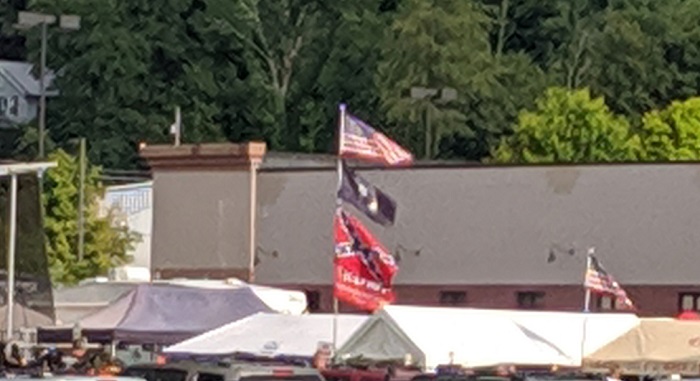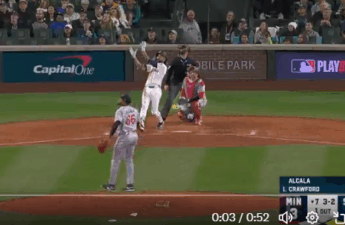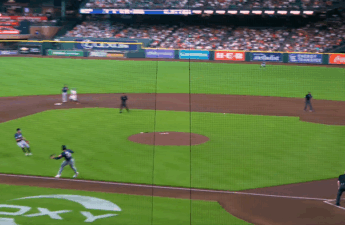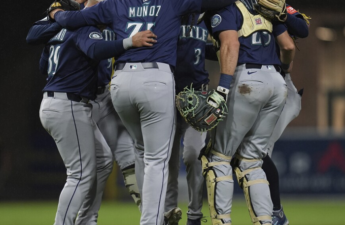I currently live in West Virginia. The reason this state exists as independent from regular Virginia, the Commonwealth of Virginia, the original colony of Virginia, is its refusal to secede from the United States of America in order to violently defend the institution of human slavery. It’s the only state that was created by a secession from a secession. So the presence and frequent proliferation of the Confederate battle flag in the state is a confounding anachronism. I guess the best analogy I can imagine is the Archbishop of Canterbury flying the flag of the Vatican above Canterbury Cathedral. Or maybe just the US Capitol flying the Union Jack. Why pledge allegiance to the entity your independence is founded upon rebelling from?
I saw the scene depicted above while taking my favorite walk in West Virginia so far, the strip of Decker’s Creek Trail that unfurls from the northern edge of South Park, the neighborhood where I reside, then wends eastward through the strip malls, lumberyards, and fast food joints of the town, toward a little patch of creekside educational signs and covered benches meant for after-school lessons in ecology and watersheds. This last spot, behind the Kroger, is the eventual destination of many of my walks, both for its serene shady setting on warm summer days and its usefulness in Harry Potter: Wizards Unite, the Pokemon-Go-style game I obsessively play on my new phone. And just to the side of the Kroger, between the trail and the main drag through Sabraton, is a patch of grass frequently overtaken for small summer concerts of cover bands that blare 80s hits into the night, thundering down on the oversized churches and the chain stores alike. What can one make of the sentiments behind this primary flagpole?
“This is my America: where we mourn those left behind in Vietnam, we mourn those who died fighting to preserve slavery at all costs, and we support Donald Trump’s efforts to wrench children from their parents at the border.” It’s hard to imagine a more clear embodiment of racism. I’m not among those who believe that all of Donald Trump’s supporters are racist, nor do I find the POW/MIA movement innately racially charged. But sliding a Confederate flag between these ideologies, especially when it appears conspicuously just slightly bigger than its neighbors (including the US flag, which I guess it would have to be, since you can’t have a rebellious flag subservient to that which it rebelled from, can you?) sure places a certain emphasis on the whole picture.
West Virginia was 93.2% white in the 2010 census and I doubt the tenure of Governor Jim Justice (elected as a Democrat, immediately switched back to being a Republican, and the only state leader to honor Trump’s request that the whole country shut down for President George H.W. Bush’s funeral) has done anything to shift that dominance. The state is fourth-worst in terms of poverty (circa 2017), alongside my adopted home state of New Mexico, the last state I lived (Louisiana), and, of course, good ol’ Mississippi. West Virginia was #2 in percentage of voters who supported Donald Trump in 2016, at 69%, behind only Wyoming’s 70%. When I showed my list of nearly twenty MFA programs I was applying to to my former college debate coach, currently an English professor and one of my recommenders, he approved all but WVU. When I pressed him on the quality of the school or its program, he clarified. “No, those are fine. But why would you want to live there?”
Morgantown, the college town that WVU single-handedly makes West Virginia’s largest by population (at about 60,000), is at least a little different. Trump won Monongalia County, yes, but with a WV-low 51%. The county is just 88% white, which is still, of course, appallingly monochrome. The University, on the other hand, is just 78% white, which is almost getting somewhere. Of course, given that half of Morgantown is enrolled at the university, this means that the non-University population is almost entirely white. Just like most of the rest of the state. No doubt these realities help keep WVU whiter than it might like to be, especially at the graduate and professorial levels. This fact was leveraged as a rallying cry when the state legislature nearly mandated the legal open carrying of firearms on campus, including in class (Texas currently has this policy). While I appreciate the power of this argument, it’s hard for me to imagine this as a tipping point for top talent considering WVU. If you’re willing to come here, you’ve already accepted that you’ll be surrounded by a certain ethos (and corresponding ethnicity). And, with luck, have the opportunity to change it.
Most of the time, I can put my head down in Morgantown, on or around campus, and not feel like I’m buried in the hinterlands of racist Trump Country. As a rule, I don’t watch local news (unless I’m on it, of course). The local day-to-day culture is kind of standoffish, wary, but eventually reluctantly friendly: warmer than the northeast, but a far cry from the warm friendliness of the west or the south. I’m reminded of pieces about the natural distrust and rivalry of mountain people, of the fabled Hatfields and McCoys, who were of course West Virginians (and Kentuckians), to say nothing of how townies must inevitably view a guy pushing forty with hair approaching the small of his back. And the campus is just a typical contemporary state school without some of the potential Midwestern charm: it reminds me of New Brunswick, NJ: a town focused obsessively on drinking, followed by frats, and finally on sports, with some academic buildings for background decor. There are no independent bookstores. There is a bar or club almost every block.
There are a few small independent cafes. Next to one of them that sits just two blocks from my apartment, the local residents, who are all in their twenties and may be students, took offense at two flags that went up at the building across the street. Those first flags were a rainbow pride flag and a Black Lives Matter flag. In response, the place next to the coffee house put up an American flag, a Trump 2020 flag, a Blue Lives Matter flag, and (curiously, especially given Pope Francis) a Vatican City flag. One night I walked home past these rival displays and found that each of the latter, except the American flag, had been ripped in half as though threshed in farm machinery. Two days later, they’d all been replaced, alongside a new handmade sign that said the premises was being filmed 24/7.
The unstated (or in the case of those events, overt) tension that sits in the middle of this street between these diametric residences feels distinctly West Virginian, or perhaps uniquely Morgantown. As a big state school, the University still draws academics and professors from across the country who were raised in the American academy, who thus believe that climate change is real, that coal is not the answer to all life’s problems, that Trump is himself a problem. The student body is distinctly more conservative than the average state school’s, but still draws heavily from Pennsylvania and Maryland, New Jersey and Ohio, even New York and Washington DC. There’s even a noted and heavily recruited pipeline of students from Kuwait and Saudi Arabia. It’s hard to pull 30,000 kids from a deeply impoverished state of 1.8 million alone.
So it’s a jarring shock to see a Confederate flag waving in the wind, just as it was to hear the aging Board members at my New Orleans nonprofit defend Confederate monuments, or to hear casual racism from riders as I drove them in my Uber. In a way, everything I’ve perceived about race has been a bit of a shock since I left seven years in the Bay Area, since I left a cocoon where I started to believe that our country really had overcome racism, a cocoon that by all accounts doesn’t really even exist in the Bay Area anymore anyway. Of course that was before Michael Brown was killed in Ferguson. It was before Trump. It was before we all lived in an era when no American could responsibly say that we’d made much progress on racism, despite whatever we may have let ourselves believe Obama meant about the country.
Last weekend, I saw Hootie and the Blowfish play a venue near a different Pennsylvania/West Virginia border than Morgantown sits near. This is the one west of Pittsburgh, east of Wheeling, where a basically all-white crowd huddled away from burgeoning thunderstorms and got much more excited about the two Darius Rucker country hits the band indulged than the song “Drowning,” which plaintively asked, in 1994, “Why is there a rebel flag hanging from the statehouse walls?” Six years later, the South Carolina legislature voted to remove the Confederate battle flag from its place atop the state capitol building, but then quickly amended the legislation to mandate that it just be flown in smaller size from a shorter pole. It wasn’t until 2015, in the wake of the AME church shooting in Charleston, that the flag finally came down.
“Why must we hate one another
When the people in the church
They tell me you’re my brother
You don’t walk like me, I said that
You don’t talk like me, saying
Go back to Africa
I just don’t understand”
We like to believe in a linear progression of time, that each day is better than the last, that each year represents upward movement to an unassailably promising future. But listening to that song and thinking about Trump telling Rep. Ilhan Omar to go back to Africa, I came to the conclusion I frequently come to. It doesn’t always get better. And that in the context of the Confederate flag I saw yesterday makes me think something else. Maybe West Virginia’s problems aren’t all that different from everyone else’s. Maybe we’re just at the forefront, on the cutting edge, the leader in opioid addiction and death, the canary in the soon-to-be-abandoned coal mine.
The original proposed name for the state of West Virginia, when it first voted to break away from mainline Virginia in 1861, was Kanawha. Depending on who you ask, this was either the name of a local Native American tribe or the word of the larger Shawnee tribe for a local geographic feature. Perhaps the name was rejected for the same reason we often decline to be reminded of the genocide the United States successfully perpetrated on the Native American peoples: we just don’t like to have to see how much of our existence is rooted in racism.



